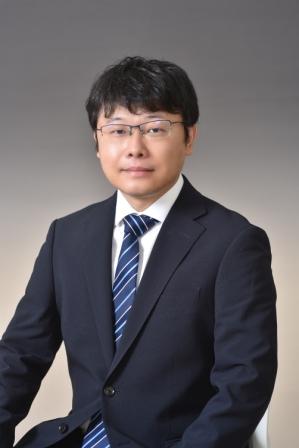Degree
-
Bachelor of Engineering Coursework ( 2016.3 Fukui University of Technology )
-
Master of Engineering Coursework ( 2018.3 Fukui University of Technology )
-
Doctor of Engineering Coursework ( 2021.3 Fukui University of Technology )
Updated on 2025/04/17

Bachelor of Engineering Coursework ( 2016.3 Fukui University of Technology )
Master of Engineering Coursework ( 2018.3 Fukui University of Technology )
Doctor of Engineering Coursework ( 2021.3 Fukui University of Technology )
Small Modular Reactors
Gel Dosimeter
Nuclear Engineering
Radiation Chemistry
Life Science / Radiological sciences / Gel Dosimeter
Energy Engineering / Nuclear engineering / Application of Small Modular Reactors
Fukui University of Technology Graduated
2012.4 - 2016.3
Fukui University of Technology Department of Applied Science and Engineering Master's Course Completed
2016.4 - 2018.3
Fukui University of Technology Department of Applied Science and Engineering Doctor's Course Completed
2018.4 - 2021.3
Fukui University of Technology
2021.4 - 2021.8
Fukui University of Technology Postdoctoral Researcher
2021.6 - 2021.8
Ontario Tech University Faculty of Energy System & Nuclear Science Post Doctoral Fellow
2021.9 - 2022.3
Fukui University of Technology Department of Applied Nuclear Technology Lecturer
2022.4 - 2025.3
Fukui University of Technology Department of Applied Nuclear Technology Associate Professor
2025.4
Atomic Energy Society of Japan
2016.4
The Japan Society of Mechanical Engineers
2017.6 - 2020.11
Japanese Society of Radiation Chemistry
2018.8
Dose evaluation study of PVA-KI gel dosimeter using RGB analysis method Reviewed International coauthorship
Takeyoshi Sunagawa, Glenn Harvel, Chisako Hishiki, Sachiko Yoshihashi, Yutaro Aoki
Memoirs of Fukui University of Technology ( 54 ) 43 - 48 2024.10
Study of in-situ measuring device for γ-ray irradiation of PVA-KI gel dosimeter Reviewed International coauthorship
Takeyoshi SUNAGAWA, Sachiko YOSHIHASHI, Glenn HARVEL, Yutaro AOKI
Memoirs of Fukui University of Technology ( 53 ) 46 - 51 2023.10
Dehydration of Decommissioning Gels for Waste Reduction Reviewed International coauthorship International journal
Glenn Harvel, Valeria Senka, Yutaro AOKI, Takeyoshi Sunagawa
5th Canadian Conference on Waste Management, Decommissioning and Environmental Restoration 2023.8
Development of in situ measuring device for irradiation of PVA-KI gel dosimeter Reviewed International coauthorship
Takeyoshi SUNAGAWA, Glenn HARVEL, Yutaro AOKI, Kyo KUME
( 52 ) 34 - 39 2022.10
Research and Development of PVA-KI Gel Dosimeter Reviewed International coauthorship
Y. AOKI, G. HARVEL, M. TAGUCHI, N. NAGASAWA, T. SAKURA, T. SUNAGAWA
2018 Pacific Basin Nuclear Conference 326 - 330 2018
Development of a Gel Type Dosimeter for X-ray Filds International coauthorship
Y. AOKI, G. HARVEL, T. SAKURA, and T. SUNAGAWA
2017 25th International Conference on Nuclear Engineering 9 ( V009T15A052 ) 2017.6
Study on dose estimation of PVA-KI gel dosimeter using RGB analysis method (Ⅲ) International coauthorship
Takeyoshi Sunagawa, Glenn Harvel, Sachiko Yoshihashi, Chisako Hishiki, Yutaro Aoki
2024.9
Applicability of SMR Technology in Japan - RI production by SMR- International coauthorship
Yutaro Aoki, Glenn Harvel
2024.9
Evaluation of X-ray Irradiation to PVA-KI Gel Dosimeter by Monte Carlo Method International coauthorship
Yutaro Aoki, Sachiko Yoshihashi, Glenn Harvel, Chisako Hishiki, Takeyoshi Sunagawa
2024.9
Study on dose estimation of PVA-KI gel dosimeter using RGB analysis method International coauthorship
Chisako Hishiki, Takeyoshi Sunagawa, Sachiko Yoshihashi, Glenn Harvel, Yutaro Aoki
2024.9
Applicability of SMR Technology in Japan Reactor -Offshore SMR- International coauthorship
Yutaro Aoki, Glenn Harvel
2024.3
Study on dose estimation of PVA KI gel dosimeter using RGB analysis method (II) International coauthorship
Takeyoshi Sunagawa, Glenn Harvel, Chisako Hishiki, Sachiko Yoshihashi, Yutaro Aoki
2024.3
Study on dose estimiation of PVA-KI gel dosimeter using RGB analysis method International coauthorship
2023.9
DEHYDRATION OF DECOMMISSIONING GELS FOR WASTE REDUCTION Invited International coauthorship International conference
G. Harvel, V. Senka, R. Khurmi, Y. Aoki, T. Sunagawa
5th Canadian Conference on Nuclear Waste Management, Decommissioning and Environmental Restoration 2023.8 The Canadian Nuclear Society
Research and development of lead block cutting technique for decommissioning nuclear power plants International coauthorship International conference
Tomohisa Gotou, Takeyoshi Sunagawa, Glenn Harvel, Yutaro Aoki
30th International Conference on Nuclear Engineering 2023.5 The Japan Society of Mechanical Engineers, The American Society of Mechanical Engineers, Chinese Nuclear Society
Considerations of applying nuclear technology in the remote northern communities of Canada International coauthorship International conference
Glenn Harvel, Yutaro Aoki
30th International Conference on Nuclear Engineering 2023.5 The Japan Society of Mechanical Engineers, The American Society of Mechanical Engineers, Chinese Nuclear Society
Applicability of SMR Technology in Japan Reactor -Thermal Application- International coauthorship
2023.3
Research and development of lead block cutting technique for decommissioning nuclear power plants Ⅱ International coauthorship
2023.3
Study of light absorption in-situ measurement by γ ray irradiation to PVa-KI gel dose meter International coauthorship
2023.3
Applicability of SMR Technology for Japan International coauthorship International conference
Glenn HARVEL, Yutaro AOKI
41st Annual Conference of the Canadian Nuclear Society 2022.6 Canadian Nuclear Society
Research and Development of PVA-KI Gel Dosimeter International coauthorship International conference
2018 Pacific Basin Nuclear Conference 2018.10 American Nuclear Society
Development of a Gel Type Dosimeter for X-ray Fields International coauthorship International conference
Y. AOKI, G. HARVEL, T. SAKURA, and T. SUNAGAWA
2017 25th International Conference on Nuclear Engineering 2017.7 American Society of Mechanical Engineers
FUT Practical Studies Exercise Ⅰ
Fundamental engineering experiment (Radiation measurement experiment)
Advanced Nuclear Power Engineering
career seminar Ⅲ
career seminar Ⅰ
Project Study
Nuclear Robotics
Nuclear Reactor Plant Engineering
Fundamental engineering experiment (Electrical and mechanical experiments)
Advanced Nuclear Energy Systems Engineering
Fundamental engineering experiment (Non-destructive testing experiments)
FUT Practical Studies Exercise Ⅱ
Differential and Integral Calculus I